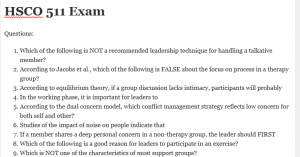HSCO 511 Exam

Questions:
- Which of the following is NOT a recommended leadership technique for handling a talkative member?
- According to Jacobs et al., which of the following is FALSE about the focus on process in a therapy group?
- According to equilibrium theory, if a group discussion lacks intimacy, participants will probably
- In the working phase, it is important for leaders to
- According to the dual concern model, which conflict management strategy reflects low concern for both self and other?
- Studies of the impact of noise on people indicate that
- If a member shares a deep personal concern in a non-therapy group, the leader should FIRST
- Which of the following is a good reason for leaders to participate in an exercise?
- Which is NOT one of the characteristics of most support groups?
- Which of the following is NOT true regarding the use of feedback during the closing stage of group?
- According to the authors, all of the following are important, but which is the MAIN focus of the closing stage of the group?
- When introducing an exercise, leaders should clearly present the directions for all of the following reasons EXCEPT to
- A member who says to another “Don’t worry, everything will be ok, you just have to make the best of things” is a _________ member.
- Spinning-off is appropriate for the following reasons, EXCEPT
- Which is NOT true about the closing phase of a session?
- Which is NOT one of the basic causes of group conflict discussed by Forsyth?
- Which of the following is NOT true regarding holding the focus when processing a group exercise?
- These are reasons for using exercises in a group, EXCEPT:
- Feedback from one group member to another is most closely associated with which therapeutic factor?
- Asking a member to leave a group might be done for all of the following reasons EXCEPT
- Personal space zones are smaller
- Interpersonal psychotherapy groups stress dealing with issues that occur within the group itself, rather than reviewing what the members are experiencing outside of the group or what they experienced in the past. This focus is usually referred to as a(n) _______ orientation.
- All of the following represent common mistakes made in middle sessions EXCEPT?
- All of the following is true about distracting members EXCEPT
- A mixed-motive situation occurs when
- Which of the following is NOT recommended as a way to handle a member’s emotional reaction to an exercise?
- When a member begins crying during the session, the leader should
- Which of the following is true regarding apportioning time to members?
- Although ALL of the following are important, the MOST important thing to attend to when leading an exercise is
- During conflicts, people are most likely to misinterpret and misperceive ________ behavior.
- Balance theory predicts that hostility is greatest when group members who dislike each other also disagree with each other. Tension is greatest when group members
- Which of the following is NOT a purpose or goal of the closing phase of a session?
- Asking members to position themselves somewhere between two walls in the room that represents their level of comfort in the group in an example of conducting a _________exercise.
- Which is FALSE about leading the middle stage of a group?
- When a group member breaches confidentiality, the authors recommend that the leader do which of the following first?
- Many 12-step programs build _______ into their change program by requiring long-term members to assist newcomers.
- Feedback exercises are most valuable when
- Which of the following is NOT an important consideration when using touching exercises?
- To deepen the focus of the group and the level of commitment of members, Jacobs et al. suggest all of the following EXCEPT
- Individuals’ perceptions of their environment are usually based on two dimensions: